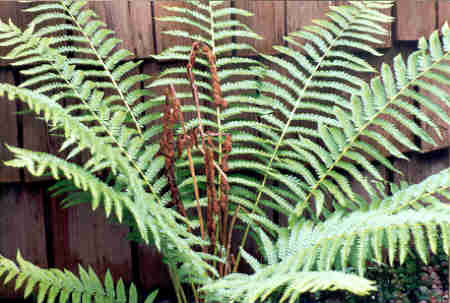






Picture courtesy of Den Linnehan
Family: Pteridophyta
It's at home in the shade. It thrives a lush, green in areas receiving little or no direct sunlight. It makes it's home where no sun loving plant or bush can survive. That makes Ferns a pretty neat plant, huh!?!
Out in the forest, there's a wide range of ferns, growing unattended. Unattended you say? Why, that must mean they require little or no attention. Why that's my kind of plant for my backyard.
Home gardeners value ferns because they are easy to grow, and there's an abundance of varieties. They make an attractive plant in the shady or wooded sections of the backyard. Try them as edging along a stand of trees. They are very attractive mixed among a group of rocks, too.
Ferns are non-flowering plants grown around the world. Scientists believe ferns are among the oldest of plants, dating back 350 million years. Over those 350 millions years, ferns have spread their rhizome roots across the globe. About the only place they are not found is desert regions, and the north and south poles.
Around the world, there are over thousands of species, although there are only about 300-400 varieties in the U.S. Some ferns grow as small as an inch, and are perfect for terrariums, or as indoor houseplants. Others grow as big as a tree, up to 50-60 feet! Most ferns have long lives, and propagate by producing spores.
Did you know? Some ferns are on the Endangered Species list. If you are going out into the woods in search of ferns to transplant, make sure you know how to identify them.
Important Note: Some ferns are poisonous. Unless you know the variety you have is safe, keep children a pets away from ferns.
How to Grow Fern Plants:
Ferns are slow to grow, but have long lives. Most people buy ferns from garden supply stores or on the Internet.
Select a location with partial to full shade. Ferns like soil that is rich in organic matter. If your soil is poor, add lots of compost and organic matter. They require the soil to be moist at all times. After planting your fern, water well.
Your plant should thrive for years with little attention. If your soil is poor, apply organic compost and mulch from time to time. In dry periods, make sure to keep the soil moist.
Most people will let the plants grow naturally. You can prune dead or damaged leaves(also called fronds).
Propagation:
Ferns produce spores (like mushrooms). Spores develop on the underside of the leaves. Millions of spores are produced. But, only a few land in a place suitable to grow. Ferns also grow by spreading their underground Rhizomes(roots).
Insect and Disease:
Insects and disease are not too common. But, if problems arise, treat early with insecticides or fungicides as appropriate.
Copyright © www.100flowers.win Botanic Garden All Rights Reserved